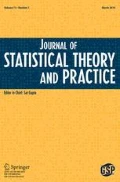Abstract
If experimental units are inhomogeneous, before running an experiment choosing a good blocked design is the first step. Traditionally, nearly all the literature use a single block variable to treat the inhomogeneity for simplicity (see Bisggard, 1994; Wu and Hamada, 2000). However, in practice the inhomogeneity often comes from multi block variables. Therefore, for this case how to optimally choose blocking for fractional factorial designs becomes an important issue. In this paper, the ideas of AENP and GMC criterion (Zhang et al., 2008) are extended to the case of blocked regular 2n-m designs with multi block variables. By transforming the blocked aliased effect-number pattern with the case of a single block variable (denoted by B1-AENP in Zhang, Wei and Li (2009)) to the case of multi block variables (denoted by B2-AENP), we propose a criterion for choosing optimal blocked designs with this case, called B2-GMC criterion. Some theoretic results are obtained. A comparison of the B2-GMC criterion with B1-GMC and four MA-type criteria is given, and the B2-GMC, B1-GMC and the four MA-type optimal blocked designs with 16-, 32- and 64-run are tabulated.
Similar content being viewed by others
References
Bisgaard, S., 1994. A note on the definition for blocked 2n-p designs. Technometrics, 36, 308–311.
Chen, B.J., Li, P.F., Liu, M.Q., Zhang, R.C., 2006. Some results on blocked regular 2-level fractional factorial designs with clear effects. Journal of Statistical Planning and Inference, 136, 4436–4449.
Chen, H., Cheng, C.S., 1999. Theory of optimal blocking of 2n-m designs. The Annals of Statistics, 27, 1948–1973.
Cheng, C.S., Mukerjee, R., 1998. Regular fractional factorial designs with minimum aberration and maximum estimation capacity. The Annals of Statistics, 26, 2289–2300.
Cheng, S.W., Wu, C.F.J., 2002. Choice of optimal blocking schemes in two-level and three level designs. Technometrics, 44, 269–277.
Cheng, Y., Zhang, R.C., 2010. On construction of general minimum lower order confounding 2n-m designs with N/4+1 = n = 9N/32. Journal of Statistical Planning and Inference, 140, 2384–2394.
Li, P.F., Zhao, S.L., Zhang, R.C., 2010. A theory on constructing 2n-m designs with general minimum lower order confounding. Statistica Sinica, in press.
Mukerjee, R., Wu, C.F.J., 1999. Blocking in regular fractional factorials: A projective geometric approach. The Annals of Statistics, 27, 1256–1271.
Sitter, R.R., Chen, J., Feder, M., 1997. Fractional resolution and minimum aberration in blocked 2 n-k designs. Technometrics, 39, 382–390.
Sun, D.X., 1993. Estimation capacity and related topics in experimental designs. PhD Dissertation, University of Waterloo, Waterloo.
Sun, D.X., Wu, C.F.J., Chen, Y.Y., 1997. Optimal blocking schemes for 2 n and 2n-p designs. Technometrics, 39, 298–307.
Wu, C.F.J., Hamada, M., 2000. Experiments: Planning, Analysis and Parameter Design Optimization. Wiley, New York.
Xu, H., 2006. Blocked regular fractional factorial designs with minimum aberration. The Annals of Statistics, 34, 2534–2553.
Xu, H., Lau, S., 2006. Minimum aberration blocking schemes for two- and three-level fractional factorial designs. Journal of Statistical Planning and Inference, 136, 4088–4118.
Zhang, R.C., Cheng, Y., 2010. General minimum lower order confounding designs: an overview and a construction theory. Journal of Statistical Planning and Inference, 140, 1719–1730.
Zhang, R.C., Li, P., Zhao, S.L., Ai, M.Y., 2008. A general minimum lower-order confounding criterion for two-level regular designs. Statistica Sinica, 18, 1689–1705.
Zhang, R.C., Mukerjee, R., 2009. Characterization of general minimum lower order confounding via complementary sets. Statistica Sinica, 19, 363–375.
Zhang, R.C., Mukerjee, R., 2009. General minimum lower order confounding in block designs using complementary sets. Statistica Sinica, 19, 1787–1802.
Zhang, R.C., Park, D.K., 2000. Optimal blocking of two-level fractional factorial designs. Journal of Statistical Planning Inference, 91, 107–121.
Zhang, R.C., Wei, J.L., Li, P., 2009. Optimal blocking for two-level regular designs under general minimum lower-order confounding criterion. Submitted.
Author information
Authors and Affiliations
Corresponding author
Rights and permissions
About this article
Cite this article
Zhang, R., Li, P. & Wei, J. Optimal Two-Level Regular Designs with Multi Block Variables. J Stat Theory Pract 5, 161–178 (2011). https://doi.org/10.1080/15598608.2011.10412058
Received:
Revised:
Published:
Issue Date:
DOI: https://doi.org/10.1080/15598608.2011.10412058



